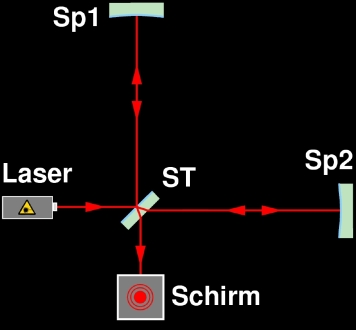In front of you, to the left, you can see a working model of a Michelson interferometer. The image shown here shows its basic layout: Light travels to a beam-splitter (in the image: ST). There, it is split into two partial waves, one travelling along one arm of the interferometer to the mirror Sp1, the other along the second arm to the mirror Sp2. Both partial waves are reflected back to the beam-splitter. There, they are superposed, and a resulting wave travels to the screen ("Schirm", in the image), resulting in an interference pattern.
The brightness of the light at the screen depends on the length of the arms: If the arms are exactly the same length, then the crests of the one partial wave, having travelled to the outer mirror and back, will meet up exactly with the wave-crests that travelled along the other arm. However, minute changes in the length of one of the arms will result in the crests of the one partial wave meeting the troughs of the other, resulting in total annihilation.
 Scene
Scene


 1st Slide
1st Slide
 Branching Point
Branching Point
 Module: Astrophysik: Gravitationsdetektoren
Module: Astrophysik: Gravitationsdetektoren Sequence: Gravitationswellendetektoren Einstieg
Sequence: Gravitationswellendetektoren Einstieg Branching Point: Gravitational wave detectors
Branching Point: Gravitational wave detectors Slide: Detecting gravitational waves
Slide: Detecting gravitational waves Back
Back


